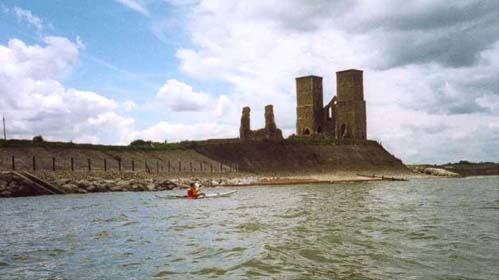
University of California, Irvine
Instructor: Dr. Barbara J. Becker

|
Week 6. Riddley Guide.
|
|
|
|
What does Goodparley's interpretation of "The Legend of St Eustace" teach us about the Inlanders? What will our interpretation of Riddley Walker teach future historians about us?
Page 119. "I hadt seen them in the lite befor. Yeller they wer. Broakin bits of yeller stoan.... Goodparley said ... 'you foun your self the yellerboy stoan the Salt 4.'"
Sulfur When Lissener and Riddley found the bag of stones (p 104), Lissener said, "Hol it in your hans and you can feal it in them stoans and scrabbing to get out you can hear it hispering to its self and clacking like a skelter of crabs." Sulfur has a very low melting point, but it is not a very good conductor of heat. If you touch a lump of sulfur, the heat of your hand will cause its surface to expand, making crackling noises as it fractures.
Page 122. "Reaky's Over" 
Reculver _____________
Roman ruins at Richborough When the Romans invaded Britain, they used Richborough (Rutupiae) as a supply depot for their troops. As they gained control over more of the area, they established Rutupiae as a fort. By the 3rd century CE, this fort was encased in massive stone walls to ward off threats from Saxon pirates.
Page 146. "When the yeller boyThat's my onwith its yours now." If "yeller boy" is sulfur and "hart of the wood" is charcoal, then what could "pig shit" refer to??? Hmmmmmmm.... Maybe Roger Bacon can provide us with a clue....... Bacon talks about making "thunder and lighting" by mixing three special ingredients: "burned shrubs" or "bones of Adam";By "burned shrubs," he means charcoal, while "vapor of Pearl" refers to sulfur. So what is the "stone of Tagus" or "Petral Stone"? None other than saltpeter (known formally as potassium nitrate, or KNO3), a white crystalline powder. Almost three hundred years after Roger Bacon penned these words, Vannoccio Biringuccio (1480 - 1539?) wrote, in his book De La Pirotechnia (1540): Now, as I told you above, this saltpeter is extracted from the above-mentioned manurial soils and from dark places that have stood turned over and loosened for a long time, provided the rain have not been able to quench the earthy dryness. The best and finest of all saltpeters is that made from animal manure transformed into earth in the stables, or in human latrines unused for a long time. Above all the largest quantity and the best saltpeter is extracted from pig dung. This manurial soil, whatever kind it may be, should be well transformed into a real earth and completely dried of all moisture; indeed it should be powdery if you wish it to be good. Assurance that it contains goodness is gained by tasting with the tongue to find that it is biting, and how much so. If you find from this trial that it has a sufficient biting power so that you decide to work it and you have found a quantity of it, it is necessary to provide yourself with kettles, furnaces, vats, or chests, and also with wood, lime, soda ash, or ashes of cerris or oak, and especially with a large hut or other walled space near water. |
|